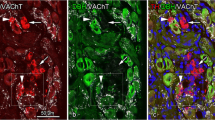Summary
A combined method was developed for characterization and differentiation of catecholamines in neuron populations containing more than one catecholamine, e.g. dopamine and norepinephrine. Its application to small intensely fluorescent (SIF-) cell clusters in sympathetic ganglia allows the successive demonstration of glyoxylic acid-induced catecholamine fluorescence and dopamine-β-hydroxylase by indirect immunofluorescence within the same tissue section. Applying this technique to an example, two types of SIF-cells were demonstrated in the guinea pig superior cervical ganglion.
Similar content being viewed by others
References
Axelsson, S., Björklund, A., Lindvall, O.: Fluorescence histochemistry of biogenic monoamines. A study of the capacity of various carbonyl compounds to form fluorophores with biogenic monoamines in gas phase reactions. J. Histochem. Cytochem. 20, 435–444 (1972)
Axelsson S., Björklund, A., Falck, B., Lindvall, O., Sevensson, L.: Glyoxylic acid condensation: A new fluorescence method for the histochemical demonstration of biogenic monoamides. Acta Physiol. Scand. 87, 57–62 (1973)
Baker, H., Burke, J., Bhatnagar, K., van Orden, D.E., van Orden, L. III, Hartman, K.: Histochemical and biochemical characterisation of the rat paracervical ganglion. Brain Res. 132, 393–405 (1977)
Björklund, A., Lindvall, O., Svensson, L.: Mechanism of fluorophore formation in the histochemical glyoxylic acid method for monoamines. Histochemistry 32, 113–131 (1972)
Bloom, F.E., Battenberg, L.F.: A rapid simple and sensitive method for the demonstration of central catecholamine-containing neurons and axons by glyoxylic acid-induced fluorescence. J. Histochem. Cytochem. 24, 561–571 (1976)
Chiba, T.: Monoamine-containing paraneurons in the sympathetic ganglia of mammals. Arch. histol. Jpn. 40, Suppl., 163–176 (1977)
Corrodi, H., Hillarp, N.A.: Fluorescenzmethoden zur histochemischen Sichtbarmachung von Monoaminen. Identifizierung des fluoreszierenden Produktes aus Dopamin und Formaldehyd. Helv. Chim. Acta 47, 911–918 (1964)
De la Torre, J.C., Surgeon, J.W.: A methodological approach to rapid and sensitive monoamine histofluorescence using a modified glyoxylic acid technique: the SPG method. Histochemistry 49, 81–93 (1976)
Elfvin, L.G., Hökfelt, T., Goldstein, M.: Fluorescence microscopical immunohistochemical and ultrastructural studies on sympathetic ganglia of the guinea pig, with special reference to the SIF-cells and their catecholamine content. J. Ultrastruct. Res. 51, 377–396 (1975)
Eränkö, O.: Small intensely fluorescent (SIF) cells and nervous transmission in sympathetic ganglia. Ann. Rev. Pharmacol. Toxicol. 18, 417–430 (1978)
Foldes, A., Jeffery, P.L., Preston, B.W., Austin, L.: Dopamine-β-hydroxylase of bovine adrenal medulla, a rapid purification procedure. Biochem. J. 126, 1209–1217 (1972)
Furness, J.B., Costa, M.: The use of glyoxylic acid for the fluorescence histochemical demonstration of peripheral stores of noradrenaline and 5-hydroxytryptamine in whole mounts. Histochemistry 41, 335–352 (1975)
Hartman, B.K.: Immunofluorescence of dopamine-β-hydroxylase. Application of improved methodology to the localisation of the peripheral and central noradrenergic nervous system. J. Histochem. Cytochem. 21, 321–331 (1973)
Kawamura, A., Jr.: Fluorescent antibody techniques and their application. Tokyo and Baltimore: University of Tokyo Press and Manchester University Park Press 1969
König, R., Heym, Ch.: Immunofluorescent localisation of dopamine-β-hydroxylase in small intensely fluorescent cells of the rat superior cervical ganglion. Neurosci. Lett. 10, 187–191 (1978)
Lindvall, O.: Combined visualisation of central catecholamine-and acetylcholinesterase-containing neurons: Application of the glyoxylic acid and thiocholine histochemical methods to the same vibratome section. Histochemistry 50, 191–196 (1977)
Lindvall, O., Björklund, A., Svensson, L.: Fluorophore formation from catecholamines and related compounds in the glyoxylic acid fluorescence histochemical method. Histochemistry 39, 197–225 (1974)
Ullrich, V., Duppel, W.: Iron and copper containing monooxygenases. In: The enzymes, P. D. Boyer (ed.), Vol. 12, pp. 294–297. New York: Academic Press 1975
Wamsley, J., Black, A., Redick, J., West, J., Williams, T.: SIF cells, cylic AMP responses and catecholamines of the guinea pig superior cervical ganglion. Brain Res. 156, 75–82 (1978)
Waris, T., Rechardt, L.: The demonstration of glyoxylic acid induced fluorescence and cholinesterase reaction in peripheral nerves in the same specimen. Proc. V. int. cong. Histochem. Cytochem. p. 367 (1976)
Waris, T., Rechardt, L.: Histochemically demonstrable catecholamines in nerve fibers of rat dorsal skin. Histochemistry 53, 203–216 (1977)
Waris, T., Rechardt, L., Partanen, S.: Simultaneous demonstration of cholinesterases and glyoxylic acid induced fluorescence of catecholamines in stretch preparations. Acta histochem. (Jena) 58, 194–198 (1977)
Williams, T., Chiba, T., Black, A.C. jr., Bhalla, R.C., Jew, J.: Species variations in the SIF-cells of superior cervical ganglia: are there two functional types? in SIF-cells; structure and function of the small, intensely fluorescent sympathetic cells: Fogarty intern. center proc. No. 30. O. Eränkö, (ed.) pp. 143–162. Bethesda, Maryland: National Institute of Health 1976
Williams, T.H., Black, A.C. jr., Chiba, T., Jew, J.: Interneurons:SIF-cells in sympathetic ganglia of various mammals. Chromaffin, Enterochromaffin and Related Cells. R.E. Coupland and T. Fujita (eds.) Amsterdam: Elsevier 1976
Williams, T., Black, A.C. jr., Chiba, T., Jew, J.: Species differences in mammalian SIF-cells. Adv. Biochem. Psychopharmacol. Vol. 16. E. Costa and G. L. Gessa (eds.). New York: Raven Press 1977
Author information
Authors and Affiliations
Additional information
Supported by the “Deutsche Forschungsgemeinschaft” grant He 919/4
Rights and permissions
About this article
Cite this article
König, R. Consecutive demonstration of catecholamines and dopamine-β-hydroxylase within the same specimen. Histochemistry 61, 301–305 (1979). https://doi.org/10.1007/BF00508451
Received:
Accepted:
Issue Date:
DOI: https://doi.org/10.1007/BF00508451




